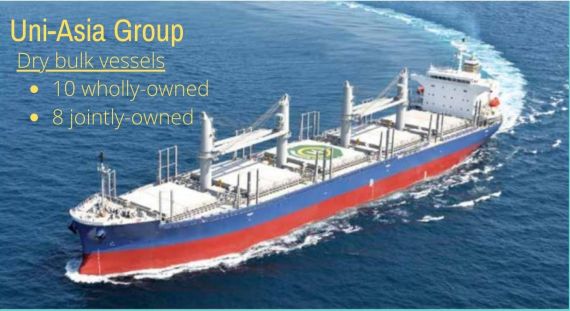Excerpts from UOB KH report
Analyst: Clement Ho
Uni-Asia Group (UAG SP)
| Incoming Record-Breaking 2021 And 2022; Too Inexpensive To Ignore Uni-Asia provided a 9M21 update, which highlighted a potential record high in 2021.
We are of the view that the company’s valuation is too inexpensive to ignore. Maintain BUY with an unchanged target price of S$2.34, pegged to 8x 2021F PE (-1SD to the mean). |
||||

WHAT’S NEW
• 9M21 operating cash flow more than tripled yoy. Uni-Asia Group (Uni-Asia) reported 3Q21 operating cash flow (OCF) of US$11.0m, exceeding 3Q20’s US$2.9m and 1H21’s US$8.1m.
| 9M21 profit estimate: US$10-12 million |
| "We estimate 9M21 net profit to be in the range of US$10m-12m (2020: US$7.7m loss), almost matching the group’s record-high net profit of US$12.1m in 2007 since its IPO." -- UOB KH report |
For 9M21, OCF of US$19.1m more than tripled yoy (9M20: US$4.8m).
Assuming stable depreciation, finance charges and absence of any one-offs in working capital, we estimate 9M21 net profit to be in the range of US$10m-12m (2020: US$7.7m loss), almost matching the group’s record-high net profit of US$12.1m in 2007 since its IPO.
Additionally, we see a high probability of an upside surprise in its 2021 dividend payout ratio.
As a gauge, a 30% dividend payout of our 2021/22F net profit forecasts of US$17.1m/US$19.6m translates to 8.8/10 S cents DPS, or 6.7%/7.6% 2021/22F yield respectively.
• Charter income anticipated to continue northward. Industry expert Marsoft expects the dry bulk market to remain strong going into the 4Q winter heating season in the northern hemisphere, as many countries look to alternative fuel sources, including coal, due to disruptions in gas supplies and soaring gas prices.
Structurally, seaborne dry bulk demand is projected to grow by 4.1% in 2021 and 1.8% in 2022 vs total dry bulk ship supply growth of 3.5% and 1.5% respectively, according to Clarksons Research.
Specifically, the handysize ship supply is projected to grow by a slower rate of 2.7%/0.6% in 2021/22.
• Baltic Dry Index not a good reflection of Baltic Handysize Index. While the Baltic Dry Index (BDI) is generally used by the industry as an indicator of drybulk freight rates, the composite index consists of sub-indices such as Baltic Capesize Index (40%), Baltic Panamax Index (30%) and Baltic Supramax Index (30%).
Typically, as handysize drybulk vessels (<40,000 dwt) are the smallest in size across the dry bulkers, it is the most versatile in cargo loads such as soft commodities, cement, clinker, mineral sands, coal and steel products.
Additionally, their smaller size allows access ports of all sizes.
Conversely, the larger Capesize (~180,000 dwt) and Panamax (~80,000 dwt) vessels are most cost effective in transporting raw commodities (coal, iron ore), hence their rates are also the most sensitive to any demand-supply changes. As a gauge, the BDI has fallen 50% over 7 Oct to 15 Nov 21.
This compares to the 20% dip in Baltic Handysize Index over the same period.
STOCK IMPACT
• Renewal of vessels’ rate to boost earnings. Of the 10 wholly-owned dry bulk carriers, four are up for renewal in 4Q21, four in 1Q22 and the remaining two in 2Q22 and 4Q22 respectively.
Based on conservative average charter rate/day of US$15,000 and US$12,459 for 4Q21 and 2021 respectively, our estimates suggest a significant turnaround in 2H21 EPS of 4.57 US cents (2H20: -4.97 US cents) and 2021 at 21.7 US cents (2020: -9.8 US cents).
With our expectation for charter rates to remain elevated in 2022 given the industry supply shortage, this suggests a further revenue growth of 15% next year, which translates to another record-high EPS of 25.0 US cents (+15.2% yoy) in 2022.
EARNINGS REVISION/RISK
• No changes to our forecasts.
| VALUATION/RECOMMENDATION • Maintain BUY with unchanged target price of S$2.34, pegged to 8x 2021F PE (-1 SD to the mean). This compares to regional peers which trade at an average 8.4x 2022F PE. • Too inexpensive to ignore. At S$1.32, Uni-Asia trades at 4.5x 2021F PE, 3.9x 2022F PE and 1.8x annualised 3Q21 P/CF. We are of the view that valuations for Uni-Asia are too inexpensive to ignore for a stock with strong earnings profile going forward. SHARE PRICE CATALYST • Higher-than-expected freight rates in the handysize segment. • Better-than-expected cost management. |
Full report here.





